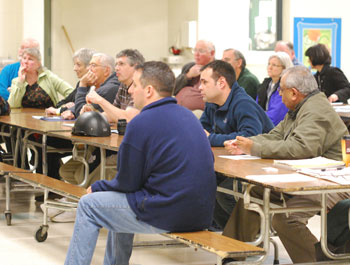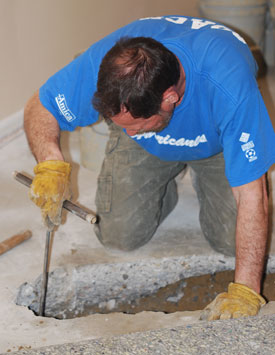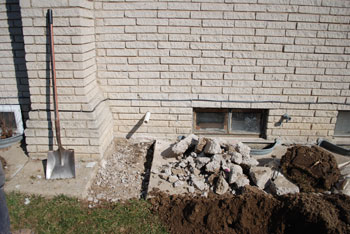Drain Disconnect Time for Homeowners
No one attending last month’s public meeting at Lawton Elementary looked happy to be there. Nor were they happy about the prospect of holes being dug in their basement and front yard. “My wife and I have lived in our house 30 years and never had a drop of water in the basement,” one man said. “Do I really need this?”

Someone from Mrs. Szalay's kindergarten class at Lawton Elementary made this drawing, which hung in the school's hallway last month on the night of a public meeting at Lawton's gym. The picture's facial expression reflected the sentiment of some homeowners who attended.
“This” is a citywide program to disconnect the footing drains in all houses from the sanitary sewer system. And the answer to his question is “yes” – because the city mandates it.
Much like the sidewalk replacement program, the effort to disconnect footing drains will span several years. But unlike the sidewalk replacement, which homeowners must pay for, the city is reimbursing costs of the drain disconnect – at least for now.
The program started in 2001 as a way to deal with chronic sewer backups in basements of some residential neighborhoods, caused during storms when stormwater would flood that sewer system. In older homes, footing drains – which are designed to divert ground water away from a house’s foundation – were often connected to the sanitary sewer system. With heavy rains, the system didn’t have the capacity to handle the additional rainwater. Sewage would back up into basements through floor drains. It wasn’t pretty
In 2000 and early 2001, a task force looked at several ways to address the problem, including expanding the capacity of the sewer system. The task force’s final recommendation – proposing a citywide footing drain disconnect – was based on cost (it would cost less to reimburse homeowners than to install larger sewer pipes or expand the wastewater treatment plant) and root cause (if the footing drains weren’t disconnected, the same phenomenon would continue). The disconnect applies to homes built before 1982 – that’s when city code changed to prohibit builders from connecting footing drains to the sanitary sewer system.
The program initially targeted five neighborhoods on the city’s southwest side, where basement backups were most acute: Bromley, Dartmoor, Glen Leven, Morehead and Orchard Hills. Within that area, over 1,300 homes have completed the disconnect – an estimated 1,600 remain to be done.
And then, of course, there’s the rest of the city.

Residents at a neighborhood meeting about the city's footing drain disconnect program, held last month at Lawton elementary.
Anne Warrow, project manager with the city of Ann Arbor, said the city has designated funds to reimburse homeowners for the disconnect work – up to $4,100 per household, which includes installing a sump pump. But it’s difficult to predict the future, she said. “That may change.”
Getting that reimbursement means following steps outlined at two public forums held last month and led by CDM Michigan Inc., a consulting firm hired by the city to manage this project. Justin Woods, an environmental scientist and project manager in the firm’s Ann Arbor office, said their role is to interact with homeowners and contractors who do the actual disconnect work.
The process works like this: Homeowners are notified by mail that they need to disconnect their home’s footing drain. (If you haven’t received a notice, they haven’t started work in your neighborhood.) Homeowners are asked to schedule a pre-inspection with CDM to determine what type of work needs to be done, such as where the sump pump should be located. The homeowner is responsible for getting a contractor – there are five contractors that are approved by the city to do this work. The contractor comes out and gives an estimate – if that estimate is higher than $4,100, the city requires getting a second estimate, and will approve the lower of the two amounts, even if it’s higher than $4,100.

Karen Duff, an environmental engineer with the consulting firm CDM, talks with a homeowner at last month's meeting about the city's footing drain disconnect program. The poster shows images of work being done to install a sump pump.
When the city approves the estimate, the homeowner schedules the work with the contractor. The work itself usually takes three days, said Karen Duff, a CDM environmental engineer. When it’s finished, someone from CDM will do a final walkthrough.
If you get a notice and don’t respond, CDM will send you a reminder, then after two months they’ll send you another notice saying you have 90 days to complete the work. “As long as you’re working the program, we’ll work with you,” Woods said. But if you don’t respond, he said, you’ll start getting a $100 penalty each month, which will show up on your water bill. Plus, you’ll no longer be eligible for reimbursement from the city.
At a March 5 public forum, attended by about 50 people, many of the questions covered technical issues:
- How often does the sump pump run, and how much will it add to the electric bill? Woods: It’s variable, depending on how much ground water is being pumped. The electricity used is minimal, and also varies according to how often the pump runs. It could be as little as $1 extra a year.
- Has the city done before and after studies about radon levels when the sump pumps are installed? Warrow: No studies like that have been done, but the sump pumps authorized for purchase are all radon sealed.
- Is a back-up sump pump required? Woods: No, but if you lose power during a storm and you don’t have a battery-powered back-up sump pump, the water flowing into the sump won’t get pumped and could overflow into the basement. It depends, Warrow added – some homeowners say their primary sump pump never runs, so they probably don’t have much ground water flowing in and wouldn’t need a back-up. (This comment prompted murmurs among residents along the lines of “If the sump pump never runs, why did they have to install it in the first place?”)
- What kind of lawn damage will this cause, and who pays for that? Woods: The contractor is responsible for cleaning up and making sure there’s as little disturbance as possible. Worst case scenario would likely be a trench 1.5 feet wide by 3 feet deep, from the house to the connecting pipe by the street. “Contractors aren’t going to go to the flower store,” he said, “but they’ll work with you.”
- What about older basements that have asbestos tile? Woods: The contractors vetted by the city are all trained in handling asbestos.

Anne Warrow, project manager for the city of Ann Arbor, talks with a resident about the footing drain disconnect program.
One man said that a lot of people in the neighborhood had just replaced their sidewalks – would they now be torn up? Woods said that contractors go underneath the sidewalk to connect the pipe from the house to the city’s green curb-drain pipe. It shouldn’t have an impact on the sidewalk, he said.
Another man questioned why there were only two Ann Arbor contractors – Perimeter LLC and Hutzel Plumbing – on the list of five approved by the city. (The other three – RDC Residential Services, Landscape Construction and Bidigare Contractors – are all based in Plymouth.) Warrow said the contractors had to go through a strict qualification process, and Woods noted that “they all do good work.” The resident wasn’t satisfied: “My point is that I live in Ann Arbor, I pay taxes in Ann Arbor, and I would like to see a contractor in Ann Arbor get the money.”
To get an idea of what the footing drain disconnect looks like, we dropped by a house on Churchill, just south of Scio Church Road, where the work was being done by Richard Connors of RDC Residential Services. He and Bob Heligman were well along in the process when we arrived: In one corner of the basement, Heligman was using a jackhammer to break up the concrete floor where the sump pump would be installed. Rob Vedder, the electrician hired for this project, was installing a new electrical circuit, which is required for the sump pump.
Connors himself was on his knees, digging a hole from where the footing drain was connected to the sanitary sewer system. After disconnecting it, he would use an auger to drill a 5-inch diameter hole from that spot over to the sump pump – they’d push a pipe through that hole, which would allow ground water to flow from the footing drain to the sump pump.
Detailed descriptions of this process can be found on the city’s website page on footing drain disconntection. What follows is a photographic documentation of some of that process from The Chronicle’s onsite visit.

Having broken up a section of the concrete basement floor, Richard Connors digs by hand to find the footing drain. He'll eventually dig a 5-inch hole from this spot over to the location of the sump pump, about six feet away, and push a pipe through that hole over to the sump. Much of that digging can be done without removing the concrete, but the dirt does need to be removed. Connors loads it into his truck and takes it to some land owned by his church.

Bob Heligman works in tight quarters as he jackhammers the concrete floor. He'll later dig a 30-inch deep hole for the sump. From there, the pump will push ground water through discharge pipes to the outside of the house.









Yes, yet another reason to live *outside* the city limits…
There’s another reason to keep groundwater and storm water out of the sanitary sewer system, and I’m surprised it isn’t mentioned in this article. It doesn’t make sense to put stormwater or groundwater into the sanitary sewer system — that water doesn’t need to be treated the way sewage waste does, and we shouldn’t spend the money and energy to do it. There is an article in the Ann Arbor Observer this month about the City’s two sewage treatment plants, one of which is offline for a major overhaul. The article mentions just how high the load on the treatment plants jumps up during rainstorms. I don’t recall the numbers, but my vague recollection is that that the volume of sewage was maybe twice what they usually get in dry weather — a very large increase in any case. All of these houses dumping rainwater into the sewage system mean we have to pay for larger plants, more capacity, more treatment, bigger pipes, etc. I’m glad the city is doing this.
I would love to introduce the kindergartner who created that fabulous artwork to my son Max. They are kindred spirits!
Thank you for the thorough, informative article. In particular, I appreciate the photographically-illustrated details of the work involved in these conversions.
I think citizens should consider several basic aspects of this program.
In some areas of the city the city did not provide adequate sewer services when they issued building permits. As a result, homes built to code at the time, get sewage in their basement. The state legislature said the city was responsible if your neighbors sewage gets in your basement. This meant the city had to fix the pipes or transfer the burden to the home owner.
The city’s solution? Obviously, transfer it to the home owner. In problem areas the home owner must disconnect any footing drains and install a check valve on the sanitary line.
The purpose of the check valve is very simple. When the sewer line is inadequate the valve closes. Now if you flush your toilet it is your sewage that will be in your basement, not your neighbors. The city is not liable for any damages from your own back-ups.
Council has recently approved many new major development projects. This means many new sewer hook-ups that the city does not have the capacity to handle. At a recent council meeting Ms McCormick stated it would be unfair to make developers pay the full cost to the city for their development.
So the disconnect program goes city wide to provided the capacity needed for new developments. The cost burden falls on those that followed the rules in the past so others benefit in the future. And once again the citizens pay the cost of development many do not want.
There are also several very specific problems with the program, as described in this article.
First, it is implied that only the five contractors approved by the city may be used. On a recent job I had bid, one of these contractors was 50% higher than the next high bid.
Second, the city has essentially sole sourced about $100 million in contracts to five contractors. Why? Am I the only one that thinks this is improper?
The true effects of deregulation and skewed market forces.
The city allowed the developers not to put in about $150 worth of sump pump and pipe, and now the city has to pay with awful basement flooding and cleanup, and up to $4,100 to fix the mistake per house. Privatize the profit socialize the cost.
The city taskforce and CDM’s “preferred” and nearly implemented plan was to build mega sewage storage tanks in several woodlands areas (with mega tree removal and mega cost) and not do the less costly disconnects. Thankfully this was stopped when thoughtful residents heard about the tank plan, although it took a lot of effort.
Unfortunately the flows from these homes go in a pipe and directly into the storm drain, at great cost. Everyone else in the country who have put in their our own sump pumps just run it to the yard.
The previous mayor appointed a task force of residents back in the 90′s to address this issue. They knew they had to get the stormwater out of the sanitary sewer and after a couple of years of debate they decided to go with this solution. Some other Michigan cities are doing the same thing and as I remember it, cities in other states as well.
Under the “Bolt” (?) decision of the Michigan Supreme Court they have to offer the “benefit” of the sump pump to every resident or to none so every neighborhood will eventually need to go through this.
Every new development has to contain all of their stormwater on site, either in a holding pond or under their building in a tank that slowly releases it after the storm has passed so I don’t see how new developments can be blamed. They also have to pay for a certain number of stormwater disconnects.
Looking back on this I always thought it was a good process and the mayor and city council in the 90′s made the right decision. I still think it was a good decision.
The only alternative was to redo all the sewer lines for greater capacity but then you would still need to process all the extra water at the sewage treatment plant so removing the water in the first place is the best way to go.
Based on personal experience, I would recommend anyone with a sump pump get a battery backed pump in addition. Waiting until after the first time you need it just leaves you with the clean-up AND the expense of buying and installing it.
The contractors may even install the y-section and check valves needed as part of the installation they are doing?
By way of full disclosure…. We live in one of the areas that experienced sewer back-ups back in the 90′s. The worst one resulted in our having the basement disinfected, the carpets thrown out and some of the drywall replaced. We lost a bunch of stuff in boxes that we just tossed rather than mess with. Most of it we never missed.
For all of the reasons above, I have followed this process closely. Our neigborhood was one of the first to go through the disconnect program and since then, our basements have been dry despite some big storms that would have flooded us in the past. It worked! Kudos to Mayor Sheldon and the residents committee that worked on this.
Dusty, Glenn was referring to the sanitary sewer needs of new developments, not their stormwater system impacts.
Glenn, do you have any specific suggestions as to how this program might be improved?
Vin, do you have any insight into why other states allow onsite discharge? Is it a leglislative difference at the state level or the local?
I wasn’t made aware of this meeting so I missed it but it’s amazing how the city seems to have a special skill for handling these events that have a major inpact but we have front page press on chicken raising issues.
“First, it is implied that only the five contractors approved by the city may be used. On a recent job I had bid, one of these contractors was 50% higher than the next high bid.
Second, the city has essentially sole sourced about $100 million in contracts to five contractors. Why? Am I the only one that thinks this is improper?”
Would $100 Million dollars have allowed a city wide upgrade to the system? And TWO Ann Arbor contractors were ‘approved’? This city council apparently cares very little about city small businesses.
“The resident wasn’t satisfied: “My point is that I live in Ann Arbor, I pay taxes in Ann Arbor, and I would like to see a contractor in Ann Arbor get the money.””
Don’t hold your breath. Once again, the city has bungled this process.
“Contractors aren’t going to go to the flower store,” he said, “but they’ll work with you.”
I love arrogance too.
“But unlike the sidewalk replacement, which homeowners must pay for, the city is reimbursing costs of the drain disconnect – at least for now.”
So the bill will ‘come due’ at some point in the future, homeowners might great stuck with the cost and the current council members and city officials will be long gone. Got it.
What a laugh to think that the contarctors will work with you on flowers and the like. When I had the misfortune of having my sidewalk repair mandated and the street I live on re-surfaced at the same time, neither cared at all about the $$$ flower gardens surrounding the projects. The city backfill crew that put dirt along the curb filled with dirt containing every imaginable weed seed including canadian thistle which I am fighting (and losing to) years later. It basically is taking over my once weed-free garden zone. The sidewalk people did the same on the other side of the walk.
In addition, the city cut into our approach but did not feather the street surface into it, so now the approach is 2″ lower than the street, so that makes for a nice puddle/ice rink every time it rains/snows. It seems to be random, they did some and not others? I guess what I am saying is don’t believe it when you are told they will work with you. I hope the disconnect program never makes it to our side of town… I am not going to have a sump installed in my totally dry, completely used/lived in walk-out basement – there is no place for it, and I won’t allow it.
I remember with the sidewalk fiasco, we called four of the contractors to get a quote (for three replacement slabs) and three companies set up times, never showed up and didn’t bother to get in touch after we left repeated phone messages. One company did finally call back after a few weeks and ended up doing a fine job at a resonable price, but getting in touch with the city with questions was yet another Kafka like experience. I’m thinking if I had wanted to know about raising chickens, there would have been a full time employee to talk with.
“I am not going to have a sump installed in my totally dry, completely used/lived in walk-out basement – there is no place for it, and I won’t allow it.”
I don’t think you understand Jeff. EVERY home in town is getting a sump pump, YOU are paying for it, either with the wasted tax dollars or a personal bill from a contractor and it doesn’t matter if your basement is dry or you’ve never had problems. And the price tag is an estimated $100 Million before it’s over.
Maybe you can submit a grant proposal, or call up the Ann Art Art Commission and have a water garden somehow included as part of your project and have an ‘artist’ come up with something that will bring in tourists.
At the risk of repeating myself. The program worked well for us and our neighborhood.
Everyone HAS to get a sump pump because under the “Bolt” decision it is regarded as a benefit so everyone needs to benefit if some do. As for the downspout disconnect, even if you have never been flooded, your home could be contributing to flooding downstream.
I don’t know any other way this could have been done.
The sidewalk program worked well for us too. We replaced three slabs.
Overall it is nice to see elderly neighbors out walking without all the trip hazards. Cities can’t possibly afford to replace all the sidewalks. The way this was done seems like the most equitable. Why should someone who has taken care of their sidewalk, replaced slabs as needed over the years, pay for those who have never had work done and need them all replaced? Most of those places are student rentals anyway. Let the landlords pay.
“EVERY home in town is getting a sump pump…”
Not true. The 5th paragraph notes the construction date cutoff for houses affected. I think the program also doesn’t apply to much older houses that don’t have footing drains, but the article doesn’t address that.
“I love arrogance too.”
Apparently so. “Physician, heal thyself.”
And I don’t think the Bolt decision has anything to do with this issue. It was the way the City chose to deal with a regulatory issue.
From the arrogance of the Art Commission, the way the sump pump program has been rolled out, to the way the Stadium Bridges issue has been addressed, you can’t help but love the world class quality of the attitude some local politicians and several city employees have displayed. I was fine with the sidewalk program, I was just addressing the issue of finding a ‘city approved’ contactor–few wanted to deal with small jobs of two or three slabs. I’m guessing the sump pump contractor process won’t be much improved either. We’ll see. And the ‘team’ that actually did the marking and determination of what needed to be replaced showed a lack of quality control, to be polite.
And of course our 4th Ward Council reps weren’t at the Lawton Q & A session either. Surprise.